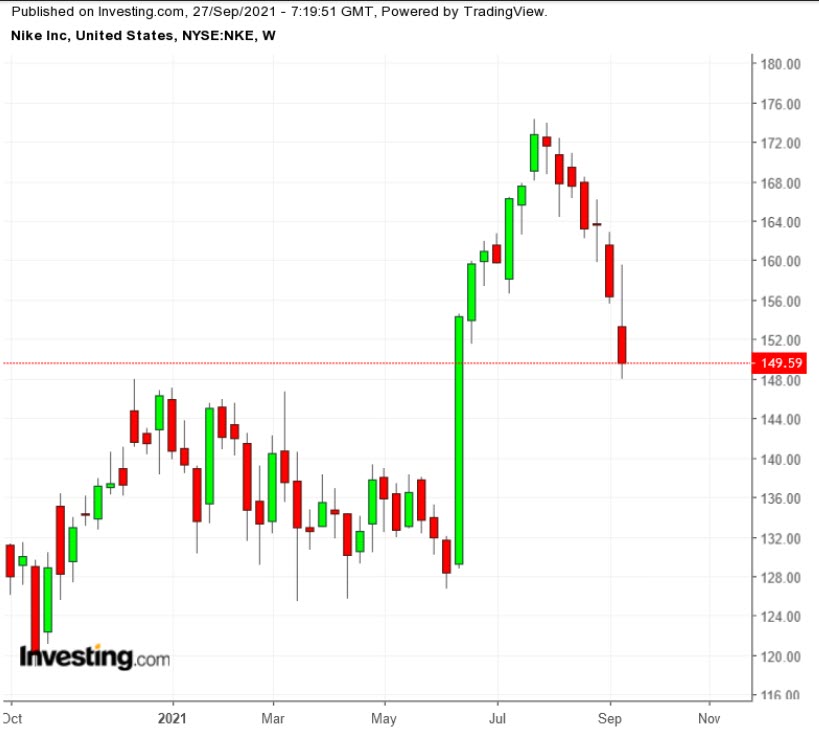Gold prices rise after heavy losses as US-China tensions resurface
Shares of sportswear giant, Nike (NYSE:NKE) have been under pressure since last week, after the sportswear giant lowered its sales forecast for the remainder of the year. The Beaverton, Oregon-based footwear and accessories behemoth has been hurt by COVID-19-related supply disruptions, which have been making it difficult for the company to satisfy soaring demand.

The stock, which this year has been the darling of growth investors, has shed about 7% since Sept. 23, when the company released its fiscal 2022, first quarter earnings, telling investors that factory closures in Vietnam, longer transit times, and labor shortages are hampering sales at the world’s largest athletic-wear company.
In the fiscal second quarter, Nike sees sales flat to down by low single digits. Analysts had been looking for revenue growth of 12% for the year, as well as a 12% increase for the second quarter, according to Refinitiv data.
This potential slowdown has halted Nike’s powerful 2021 rally, which sent the stock to an all-time high last month. Shares, which closed at $149.59 on Friday, have lost 14% from their peak. This dip, in our view, is a buying opportunity for long-term investors currently sitting on the sidelines.
Our bullish call on Nike is two-fold. First, the hurdles the company is facing are related to snags in supply; demand for its products remains strong. For perspective, the past quarter produced Nike’s second-highest, three-month revenue figure ever, just behind last quarter’s sales mark. NKE's earnings-per-share figure set a record for the company.
This robust demand trend is likely to continue as the world slowly overcomes the pandemic and more and more countries open their economies.
Thriving Online Sales
The other reason we believe Nike remains a long-term buy: the maker of Air Force 1s as well as Jordan and Converse footwear has been successful in improving its direct-to-consumer business during the pandemic. And there's strong evidence its online sales have more room to expand.
The global health crisis has accelerated Nike’s shift to e-tail. It has created a direct-to-consumer business that's not just efficient but also responsible for improving the enterprise's profit margins. For several quarters, Nike’s online sales have surged more than 80%, exceeding the company’s target for revenue from this segment. It now makes up 30% of total sales.
During last week's conference call, Chief Financial Officer Matt Friend said, of online sales:
“Digital is increasingly becoming a part of everyone’s shopping journey, and we are well positioned to reach our vision of a 40% owned digital business by fiscal 2025.”
Despite the uncertainty in the company’s near-term growth outlook, analysts on Wall Street continue to remain bullish on the stock, advising clients to take advantage of the weakness. According to analysts at UBS:
“While some uncertainty still exists around how long it will take supply-chain issues to clear up and if Nike’s China sales growth rate will accelerate, our view is investor sentiment will improve now that Nike has quantified the Vietnam factory shutdown impact.”
UBS rates Nike shares a buy with a $185 price target.
Stifel, which rates the stock a buy as well, with a $213 price target, said in its note to clients last week:
“We remain compelled by the business transformation to a higher margin, higher return economic model. Accordingly, we continue to view Nike as a top-tier core holding for large-cap growth investors and recommend using any weakness in shares in response to supply challenges as an opportunity to build positions.”
Bottom Line
Nike shares will likely face more weakness after the company disclosed supply-side issues and the uncertain outlook for its sales in the coming quarters. That weakness should be taken as a buying opportunity by investors who have a long-term investment horizon, given the strength of Nike’s brands and its ongoing push to expand its low-cost online sales.
